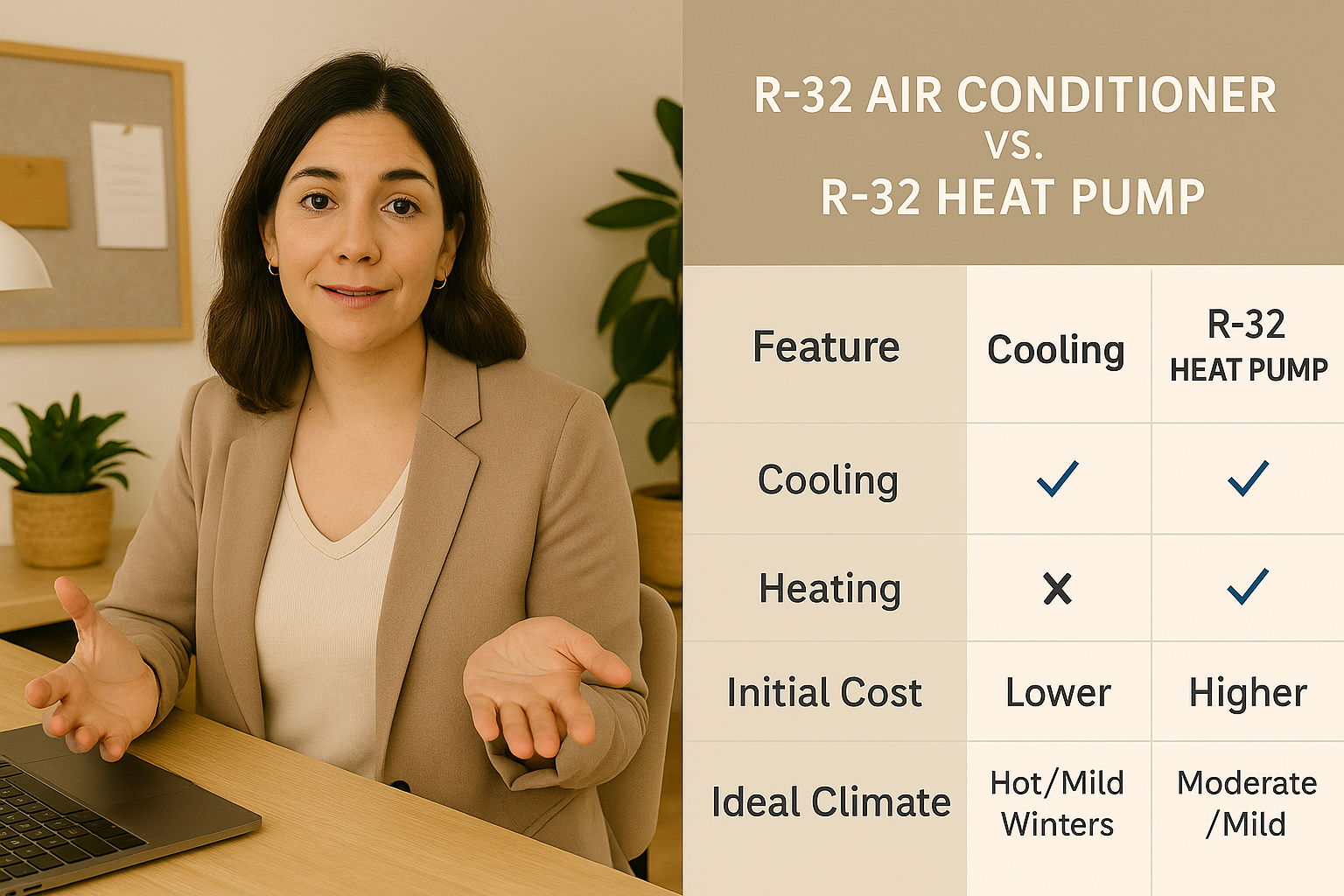If you're in the market for a new HVAC system and want to stay ahead of efficiency standards, chances are you’ve run into two high-performance options: R-32 air conditioners and R-32 heat pumps. Both use the next-gen refrigerant R-32, known for its low Global Warming Potential (GWP), but they function quite differently—and choosing the right one can make a big difference in comfort, energy savings, and long-term costs.
So which one should you choose? Let’s break it down like Savvy would—clear, honest, and tailored to real-world homeowners.
🧊 First, What’s the Difference Between an AC and a Heat Pump?
Both air conditioners and heat pumps do the same thing in cooling mode: remove heat from your home and expel it outside using refrigerant. In this case, both systems use R-32, a more eco-friendly alternative to R-410A.
The key difference?
-
❄️ Air Conditioner: Only cools.
-
🔁 Heat Pump: Cools and heats by reversing the refrigerant cycle.
A heat pump can pull heat from outside (even in cold temps) and move it indoors in winter. That means it can replace your furnace, or supplement it in a dual fuel system.
♻️ R-32: A Smarter Refrigerant for Both
Both heat pumps and air conditioners are increasingly built with R-32 refrigerant because of its:
-
Lower Global Warming Potential (GWP of 675 vs. 2088 for R-410A)
-
Greater energy efficiency
-
Lower refrigerant charge requirements
-
Simpler recycling (single-component molecule)
🧪 Learn more from Daikin’s R-32 Environmental Overview.
Bottom line: Regardless of whether you choose an AC or heat pump, going with an R-32 system helps future-proof your HVAC against regulatory changes—and reduce your carbon footprint.
📊 Feature-by-Feature Comparison
| Feature | R-32 AC | R-32 Heat Pump |
|---|---|---|
| Cooling | ✅ Yes | ✅ Yes |
| Heating | ❌ No | ✅ Yes |
| Initial Cost | 💰 Lower | 💰💰 Higher |
| Energy Savings | ✅ Seasonal | ✅ Year-round |
| Ideal Climate | Hot/mild winters | Moderate/mild |
| Furnace Required | ✅ Yes | ❌ Optional |
| Rebates Eligible | ✅ Often | ✅✅ Often Higher |
🌎 Climate Zone: The Biggest Decider
Where you live should be your starting point.
❄️ Cold Climates (e.g., Minnesota, Maine, Montana)
-
Opt for an R-32 AC + Gas Furnace
-
Heat pumps struggle below ~30°F without a backup
-
Your furnace does the heavy lifting in winter
🌤️ Mild to Moderate Climates (e.g., Tennessee, North Carolina, Arizona)
-
R-32 heat pumps shine here
-
More days where electricity is cheaper/more efficient
-
Optional gas backup = dual fuel system savings
🔎 Use the DOE's U.S. Climate Zones Map to see what zone your home is in.
💰 Upfront Costs vs. Long-Term Savings
| R-32 AC | R-32 Heat Pump | |
|---|---|---|
| Equipment Cost | $ | $$ |
| Install Cost | $–$$ | $$–$$$ |
| Operating Cost | Higher (gas heat) | Lower (electric heat) |
| Annual Savings | Moderate | High (especially if replacing furnace) |
While heat pumps cost more upfront, they can save you significantly on winter heating bills, especially if you live in a region with cheap electricity.
According to Energy Star, high-efficiency heat pumps can cut heating costs by up to 50% compared to electric resistance or oil/gas heating.
⚙️ Installation Requirements
Both systems require:
-
Proper sizing (Manual J load calculation)
-
Compatible ductwork
-
Correct refrigerant line sets and charging
Unique to heat pumps:
-
Thermostat with heating/cooling modes
-
Outdoor defrost cycles
-
May need backup electric strip heat or gas furnace in cold regions
📘 Learn more about proper installation from the Air Conditioning Contractors of America (ACCA).
🧠 Smart Use: Hybrid Heating = Best of Both
If you’re on the fence, why not combine the best of both worlds?
A dual fuel system pairs an R-32 heat pump with a high-efficiency gas furnace:
-
Uses the heat pump down to ~35°F
-
Switches to gas below that
-
Controlled by a smart thermostat (like ecobee or Honeywell T10)
This setup can reduce your heating bills by 30–50% while still keeping you warm on the coldest days.
📖 See this guide on Heat Pump vs. Furnace Efficiency in Hybrid Systems.
🔋 What About All-Electric Homes?
If you're going all-electric, a heat pump is your only choice.
Look for:
-
R-32 refrigerant for environmental compliance
-
ENERGY STAR® certified models
-
SEER2 and HSPF ratings that exceed local code
You may also qualify for Inflation Reduction Act (IRA) tax credits and state rebates.
🧾 Check eligibility through the Rewiring America Incentive Calculator.
🧾 Rebates and Tax Credits
Both R-32 air conditioners and heat pumps may qualify for:
-
Federal tax credits (up to $2,000 for heat pumps)
-
Local utility rebates
-
ENERGY STAR® incentives
⚡ Learn more from the Database of State Incentives for Renewables & Efficiency (DSIRE).
🛒 Explore R-32 Systems at The Furnace Outlet
We carry a full range of R-32-based systems, including:
-
3-ton R-32 Air Conditioners
-
3-ton R-32 Heat Pumps
-
Dual Fuel Packages (heat pump + gas furnace)
Every system is backed by:
-
High-efficiency ratings
-
Smart thermostat compatibility
-
Expert tech support for sizing, setup, and rebates
👉 View Our R-32 Product Collection
✅ Final Recommendation: What Savvy Suggests
“Your comfort system should match your climate, your energy goals, and your wallet—not just a brand name or buzzword.”
— Savvy
Here’s a recap:
| If You Want... | Go With... |
|---|---|
| Cooling Only + Gas Heat | ✅ R-32 Air Conditioner |
| All-Electric Home | ✅ R-32 Heat Pump |
| Year-Round Energy Savings | ✅ R-32 Heat Pump |
| Ultimate Flexibility | ✅ Dual Fuel System |
📚 External Resources
In the next topic you will read about: How to Install an R-32 AC + Gas Furnace System: Pro or DIY?







